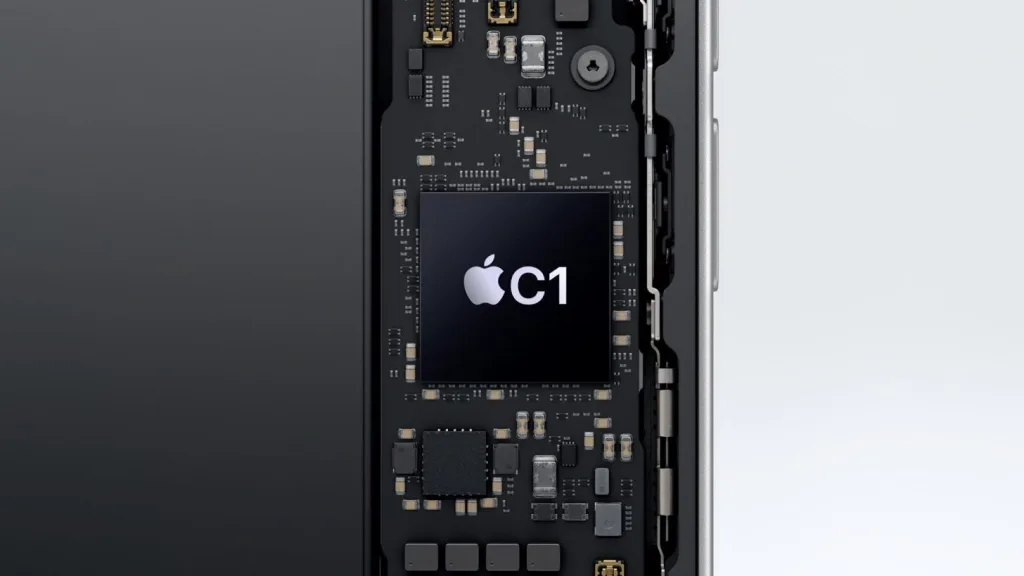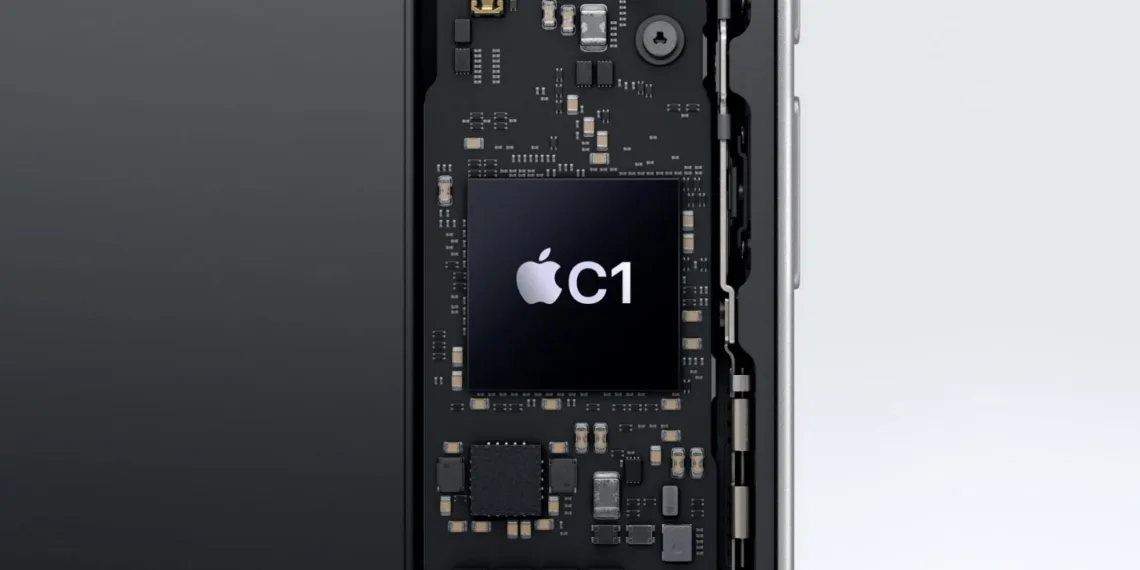Apple has taken another significant step toward hardware independence with the launch of its first in-house 5G modem, the C1, debuting in the iPhone 16e. While the company remained tight-lipped during its official unveiling, fresh reports reveal that the C1 modem is being mass-produced using a hybrid approach—TSMC’s 4nm and 7nm process nodes. This strategic move ensures improved power efficiency while keeping costs in check, reinforcing Apple’s long-term vision of controlling both hardware and software for optimized performance.
Table of Contents
C1 5G Modem: Built with a Hybrid Lithography Process
Unlike Apple’s A18 chip, which powers the iPhone 16e using TSMC’s cutting-edge 3nm (N3E) process, the C1 modem takes a more cost-efficient approach. According to Apple’s Senior VP of Hardware Technologies, Johny Srouji, the C1’s baseband chip is fabricated on TSMC’s 4nm process, while its transceiver leverages the 7nm node.
This hybrid fabrication technique is likely a cost-saving measure, ensuring a balance between power efficiency, performance, and production expenses. Had Apple opted for the more advanced 3nm node, the cost of the iPhone 16e—currently starting at $599—could have been significantly higher.
Why Apple Chose TSMC’s 4nm & 7nm Over 3nm for the C1?
Apple’s decision to use 4nm for the baseband chip and 7nm for the transceiver instead of 3nm (N3E), as seen in the A18 chip, likely stems from two key factors:
- Cost Efficiency: A 3nm modem would have increased manufacturing costs, potentially leading to a higher retail price for the iPhone 16e.
- Power Optimization: Apple claims the C1 is its most power-efficient modem ever, which directly translates to improved battery life compared to previous iPhones.
By leveraging TSMC’s proven 4nm and 7nm technologies, Apple strikes a balance between performance and affordability, ensuring a seamless user experience without significantly impacting the device’s cost structure.

A Major Compromise: No mmWave Support in the C1 Modem
While the C1 modem delivers impressive power efficiency, it comes with one notable drawback—the lack of mmWave support. This omission means that the iPhone 16e won’t benefit from the ultra-high-speed downlink and uplink capabilities found in Apple’s iPhone 16 models equipped with Qualcomm’s Snapdragon X71 5G modem.
For users who rely on mmWave networks for blazing-fast data speeds, this could be a significant limitation. However, Apple seems to be prioritizing battery life and cost savings over peak 5G speeds—at least for now.
Apple’s Long-Term Vision for In-House 5G Modems
Apple’s move to design its own 5G modem is part of a broader strategy to reduce dependence on third-party chip suppliers like Qualcomm. Since acquiring Intel’s modem division in 2019, Apple has been steadily developing its own 5G solutions, aiming to have greater control over its device ecosystem.
How the C1 Modem Fits into Apple’s Silicon Roadmap
Apple has already demonstrated its ability to revolutionize chip design with the transition to Apple Silicon for Mac, replacing Intel processors with its highly efficient M-series chips. Similarly, Apple’s A-series chips in iPhones have consistently set industry benchmarks for performance and power efficiency. The C1 modem represents another significant step in this journey.
Apple’s in-house modem development brings several advantages:
- Deeper hardware-software integration for optimized 5G performance.
- Better power efficiency, leading to extended battery life.
- Reduced reliance on Qualcomm, which currently provides 5G modems for the iPhone lineup.
- Potential cost reductions in the long run as Apple refines its modem technology.
Challenges Apple Faces with Its Own 5G Modem
While Apple’s move to develop an in-house modem is ambitious, it comes with significant challenges:
- Performance Parity with Qualcomm: Qualcomm has years of expertise in developing 5G modems. Apple’s C1 must match or exceed the Snapdragon X71’s capabilities to be considered a true competitor.
- Regulatory Hurdles: Modems require extensive carrier certification and testing worldwide. Apple must ensure the C1 is compatible with various network infrastructures.
- mmWave and Future Technologies: Apple’s C1 lacks mmWave support, meaning it may not be suitable for users in markets where mmWave is widely deployed. Future versions must address this limitation.
How the C1 Compares to Qualcomm’s Snapdragon X71
Power Efficiency
Apple claims that the C1 modem delivers superior power efficiency, contributing to longer battery life. While Qualcomm’s Snapdragon X71 is also optimized for efficiency, Apple’s tight hardware-software integration could provide a real-world edge.
5G Speed & Performance
Qualcomm’s Snapdragon X71 supports both sub-6GHz and mmWave 5G, whereas the C1 lacks mmWave support. This gives Qualcomm an advantage in markets where mmWave is widely available, such as the U.S.
Battery Life
By optimizing the C1 for Apple’s hardware, iPhone 16e users could see significant battery life improvements compared to previous models using Qualcomm’s modems. However, real-world tests are needed to confirm these claims.
Cost Implications
Apple’s C1 modem lowers component costs, allowing the iPhone 16e to start at $599. This cost advantage may make future iPhones more affordable while maintaining premium features.
Apple Remains Silent on C1’s Performance Metrics
Despite Apple’s bold claims regarding power efficiency, the company has not released any performance benchmarks for the C1 modem. Unlike Qualcomm’s Snapdragon X71, which boasts industry-leading 5G speeds, Apple has yet to provide a direct comparison of its in-house modem’s real-world performance.
This leaves the tech community eagerly awaiting third-party speed tests, signal strength comparisons, and power consumption benchmarks to see how the C1 stacks up against its competitors.
What This Means for Apple’s Future in 5G
Apple’s transition away from Qualcomm marks a pivotal moment in its pursuit of self-reliance in chip development. The C1 modem is just the beginning, with future iterations expected to bridge the current performance gaps and potentially introduce mmWave support.
With TSMC’s 3nm (N3E) technology maturing, it’s possible that Apple’s next-gen 5G modem (C2 or later) will adopt a more advanced node, offering even better efficiency and performance.
Final Thoughts
Apple’s C1 5G modem represents a major milestone, offering greater power efficiency and cost optimization but at the expense of mmWave support. By leveraging TSMC’s 4nm and 7nm processes, Apple ensures that the iPhone 16e remains affordable while delivering improved battery life. However, the lack of performance metrics and mmWave capabilities raises questions about how well the C1 will hold up against Qualcomm’s established Snapdragon 5G solutions.
As the first step in Apple’s self-sufficient 5G journey, the C1 modem signals an exciting future, but whether it truly outperforms its competitors remains to be seen. Stay tuned for real-world performance tests to see how well Apple’s first in-house 5G modem lives up to the hype!








